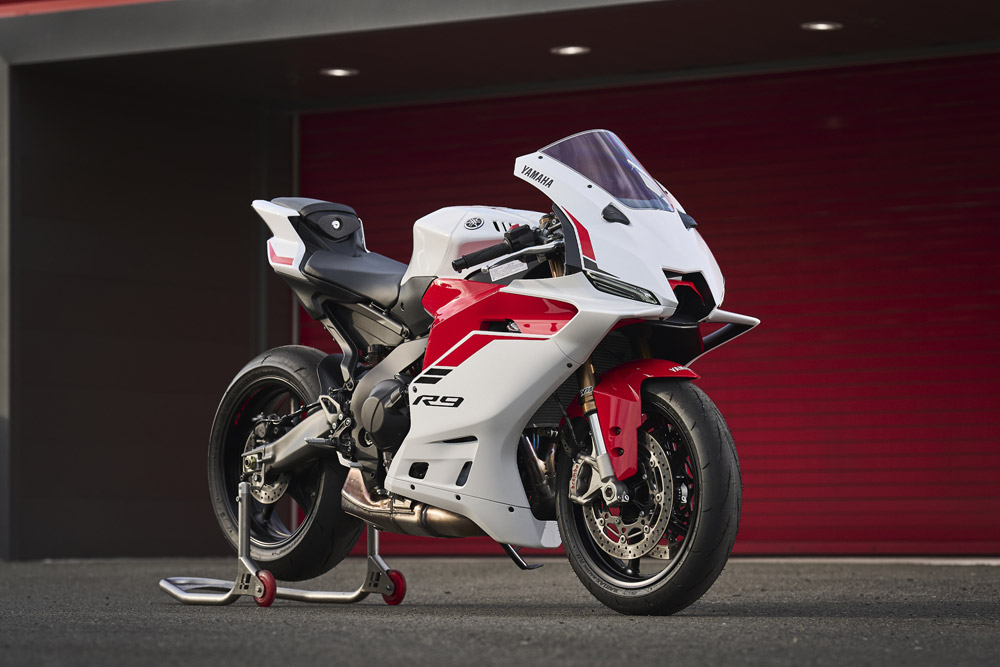We are amid a sportbiking renaissance with the supersport class firing like never before, and we can now welcome the newest player to the game in the Yamaha YZF-R9.
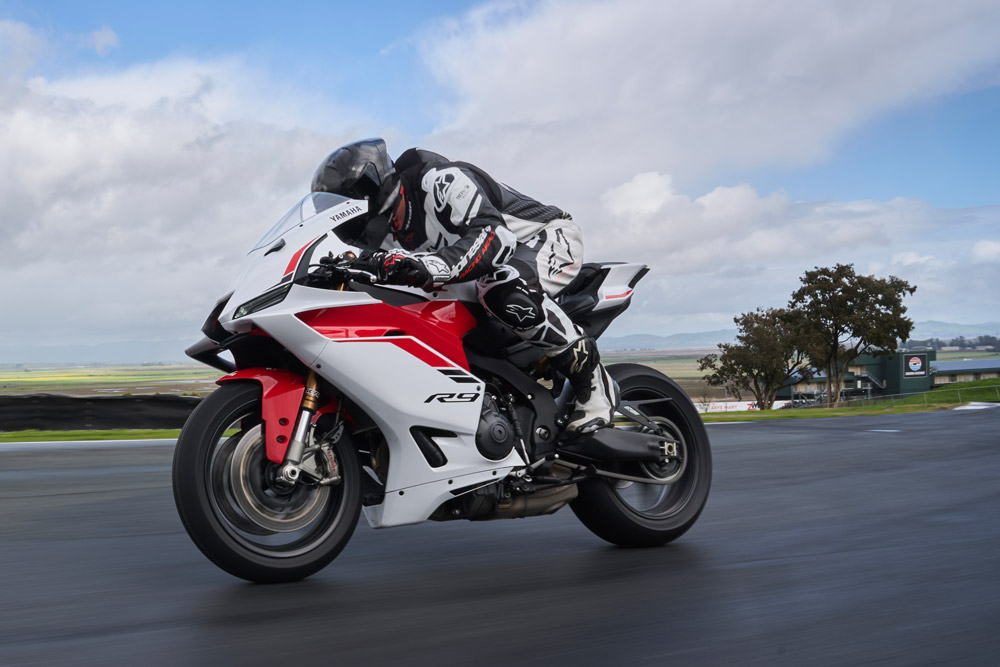
Photography by Joseph Agustin
There has been hardly a machine more talked about, more argued over ever since news broke in 2021 that Yamaha was going to make a three-cylinder sportbike based on the MT-09 back. Admittedly, it’s taken a little longer to come to market than they’d hoped, but that’s good news for us because the tuning-fork company wanted to make sure they got this thing absolutely spot on before letting the public loose on it.
The R9 taps into the mindset of less aggression and more comfort that is slowly permeating through the sportbiking world. In much the same guise as the Ducati Panigale V2 S, the R9 is trying to give riders a greater degree of comfort that allows them to ride faster for longer via a more relaxed riding position, more space between your knee bend and less weight on your wrists.

Compared to the outgoing Yamaha YZF-R6, a machine that’s about as hard-edged and focused as a supersport machine could possibly be, the R9 is up for a bit of a laugh. This is, after all, a machine based primarily on the king of hooliganism in the MT-09 naked bike; however, in sportbike drag, the three-cylinder still has the performance to match the YZF tagline.
Yamaha’s CP3 inline three-cylinder motor is a very known quantity. Part of the Yamaha family since the first MT-09 in 2013, it has slowly been massaged from a snappy, brute of a thing into one that is now Yamaha’s most dependable power unit, seeing duty in the MT-09/MT-09 SP, XSR900, the Tracer 9 GT, and the bike we sadly don’t get in America in the brilliant XSR900 GP. Yamaha claims 117 horsepower and 69 lb-ft of torque for the 890cc triple, which puts it pretty much in line with the Panigale V2 S we tested a month ago in Spain.
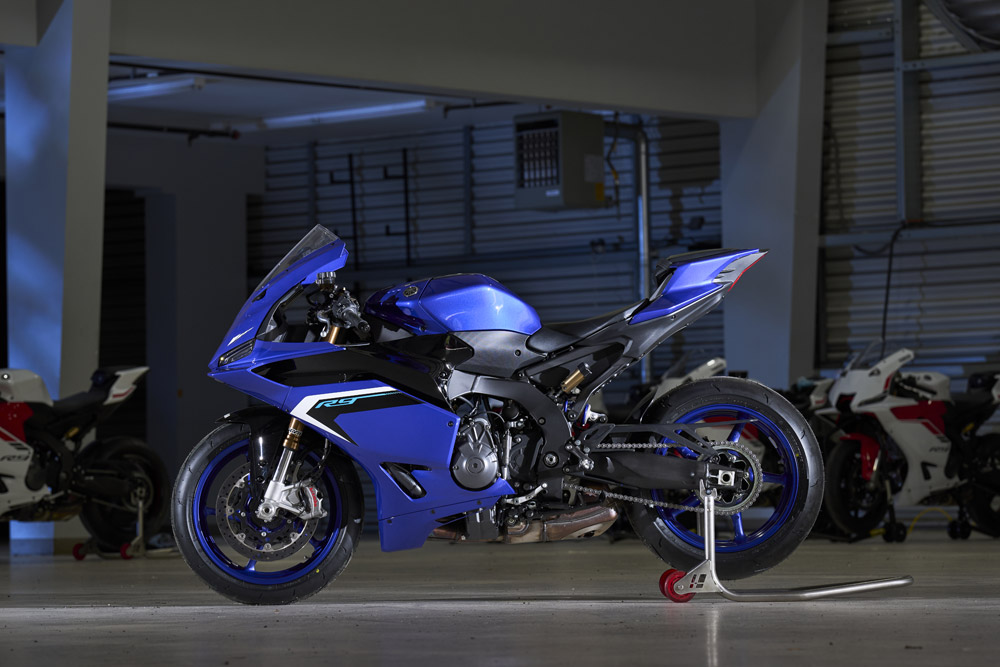
Compared to the outgoing four-cylinder R6, the R9 has around 23 lb-ft of torque more but more importantly than that, it spreads it over a wider rev range. During our day at Sonoma—in the pouring rain—this came in very handy as you didn’t have to constantly shift gears to keep the revs sky-high for dependable performance.
The CP3 still suffers from the dreaded flat spot between 5000-6500 rpm, which is due to emissions. Regardless of your position on the twist grip, the ECU just won’t let the throttle butterflies open as quickly as you’re asking them if you’re in this particular point of the rev range. A quick look at the data confirmed this, but if you do go and pick up an R9, stick an aftermarket pipe on and take it to a good tuner, they will largely be able to eradicate the problem.
The CP3 motor is mated to Yamaha’s six-speed gearbox with quite widely spaced ratios. This hints to the streetbike nature of the machine, as opposed to a short-ratio race-inspired six-speed unit.
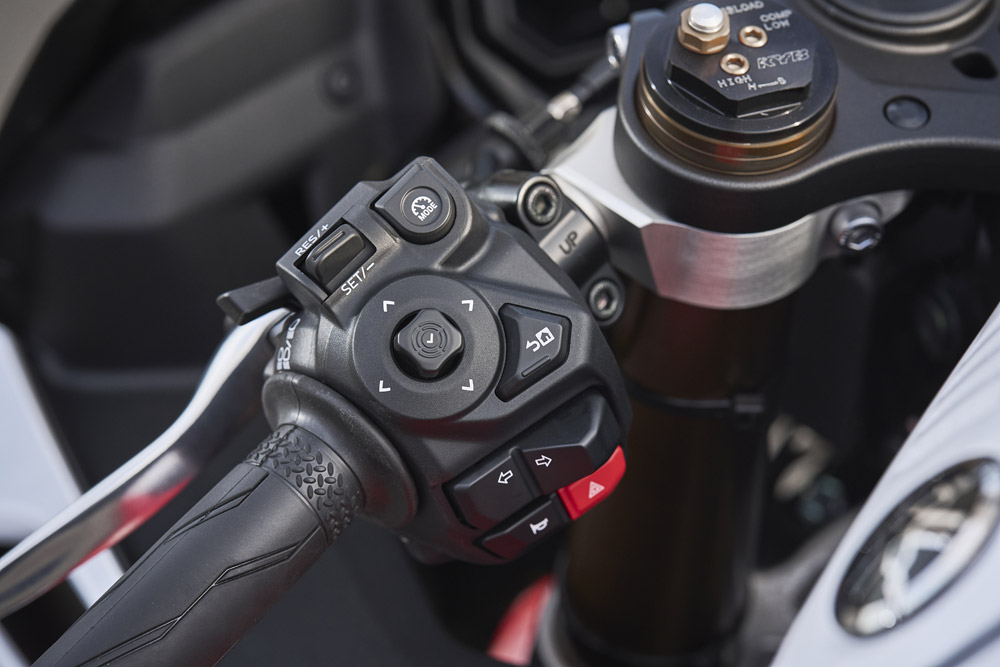
You can thus hold gears for a long time (at least in the wet), keeping the motor surfing its buxom torque curve and keeping the bike driving forward. Racers may find these ratios not aggressive enough, although Stefano Manzi would probably disagree, having taken the R9 to victory lane on his very first attempt at Phillip Island.
The performance, as usual, is metered through the Bosch six-axis IMU-fettled electronics and the expansive Yamaha rider suite system. In it sit three modes in Sport, Street and Rain, a couple of customizable Rider modes and an extra four racetrack modes. These give you access to the engine power modes; slide-, traction-, launch- and wheelie-control levels; ABS that can be disengaged on the rear; and your quickshifter levels. And for the road riders out there, don’t forget you get cruise control as standard.
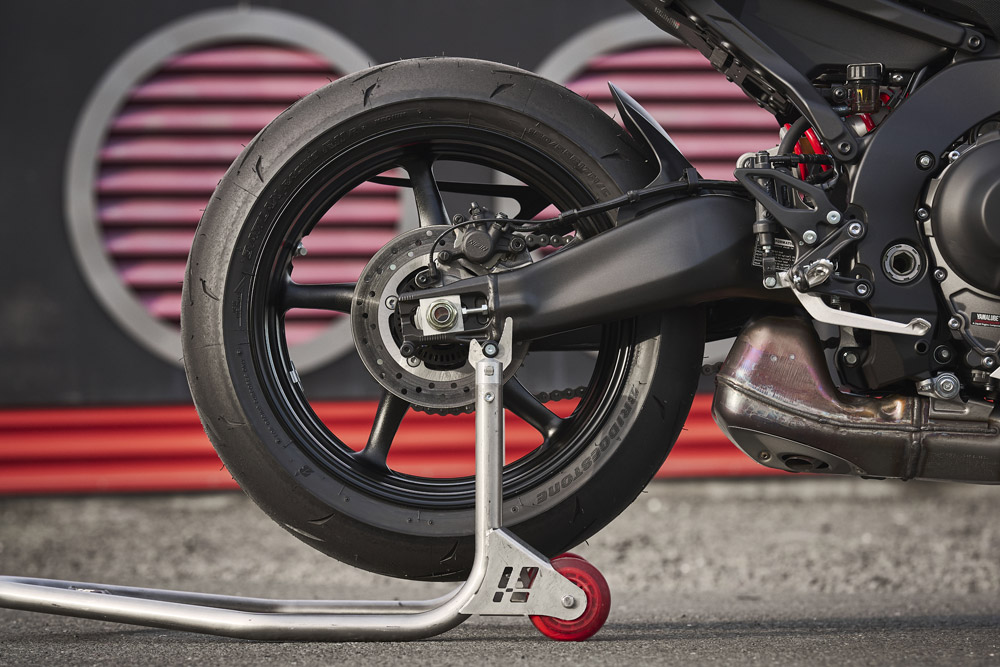
All this is altered by the five-inch TFT dash that also gives you access to the Yamaha app in which you can really delve into the data, such as throttle position, track mapping, and where and when certain systems were activated.
Seeing as our ride was almost entirely in the pissing down rain, traction control was registered on the higher side than what I would normally use, but the electronic intervention is so smooth these days. Gone are the days when these systems were a hindrance, their effectiveness being proven by the fact that no one crashed on a day in which the Yamaha execs would have been more than happy if only one bike went down.
Compared to the MT-09-derived engine, the R9’s Deltabox chassis is a bespoke unit. The name of the game here was increased stiffness for racetrack potential compared to the flexi-frame of the MT-09.
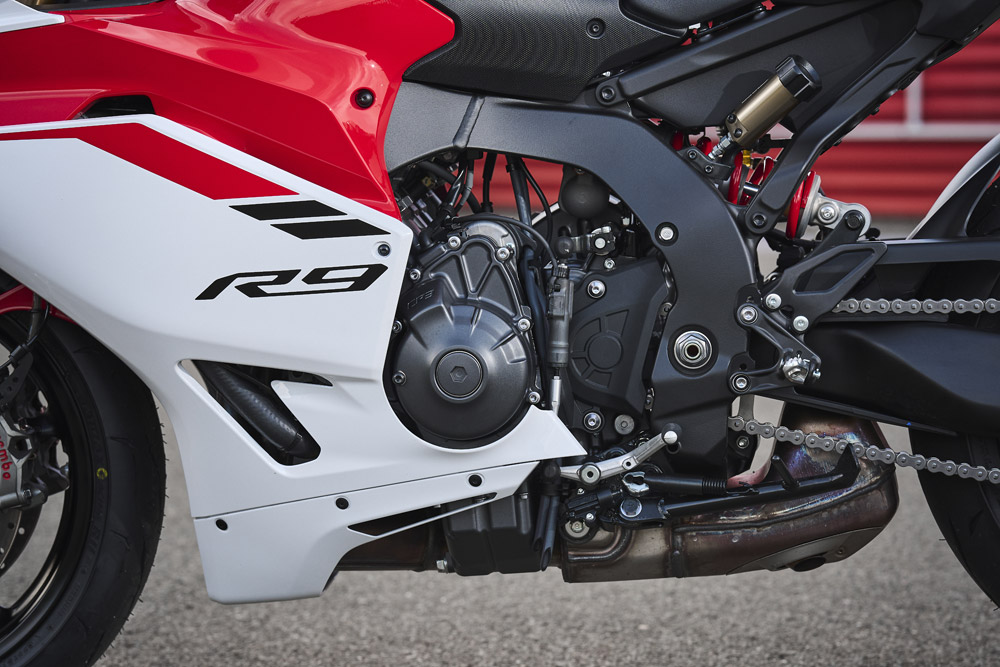
Yamaha engineers gave the R9 16 percent greater lateral stiffness, 18 percent more torsional and 37 percent more longitudinal stiffness, plus a 2.1° steeper rake angle at 22.6°. The wheelbase is also slightly shorter as well at 55.9 inches to the MT-09’s 56.7 inches. Despite this, the R9 is incredibly stable, especially under brakes. Yamaha has finally ditched the Advic brakes for Brembo Stylema monoblocs with steel braided lines, and the improvement to braking performance is out-of-sight (at least Yamaha is now on par with pretty much everyone else).
The riding position helps here. With Yamaha placing the handlebars 8mm higher and 10mm forward, it helps you get the weight over the front wheel easier and more comfortably so it’s repeatable. Load that (wet) front tire up on the entry to turn four at Sonoma and let the chassis take care of the rest.
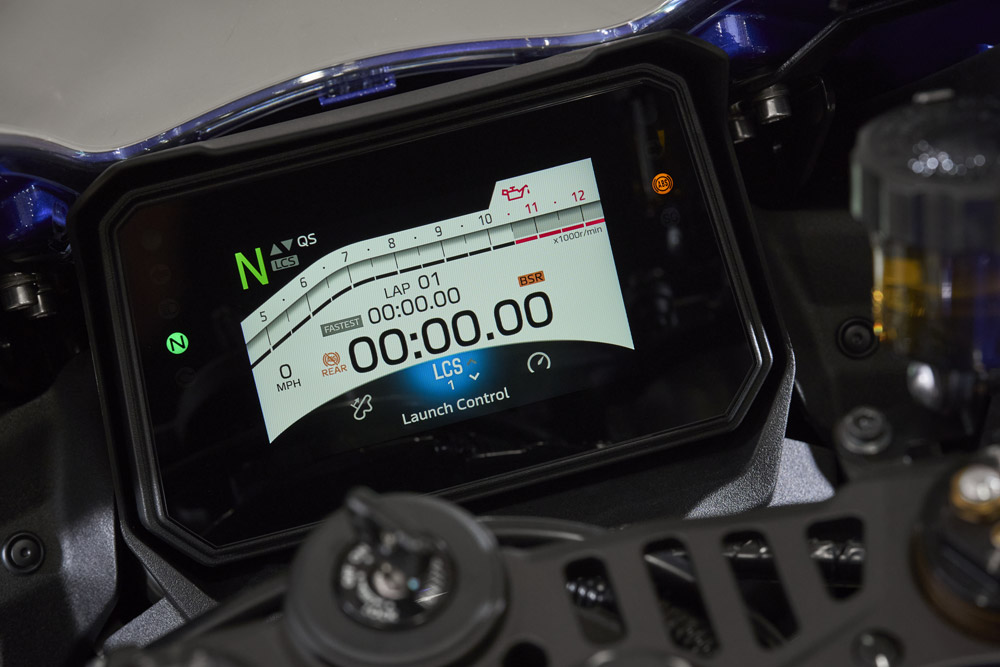
The R9 doesn’t steer as quickly as the R6, but it’s not meant to. It’s more stable and forgiving, more approachable in how it goes about making fast lap times. KYB has graced the R9 with its separate rebound and compression damping forks, and a new KYB shock that helps smooth out the first 10 percent of compression makes for an extremely smooth ride. Again, as we were only testing in the wet, the suspension didn’t get pushed as hard as it would in the dry but initial impressions were good.
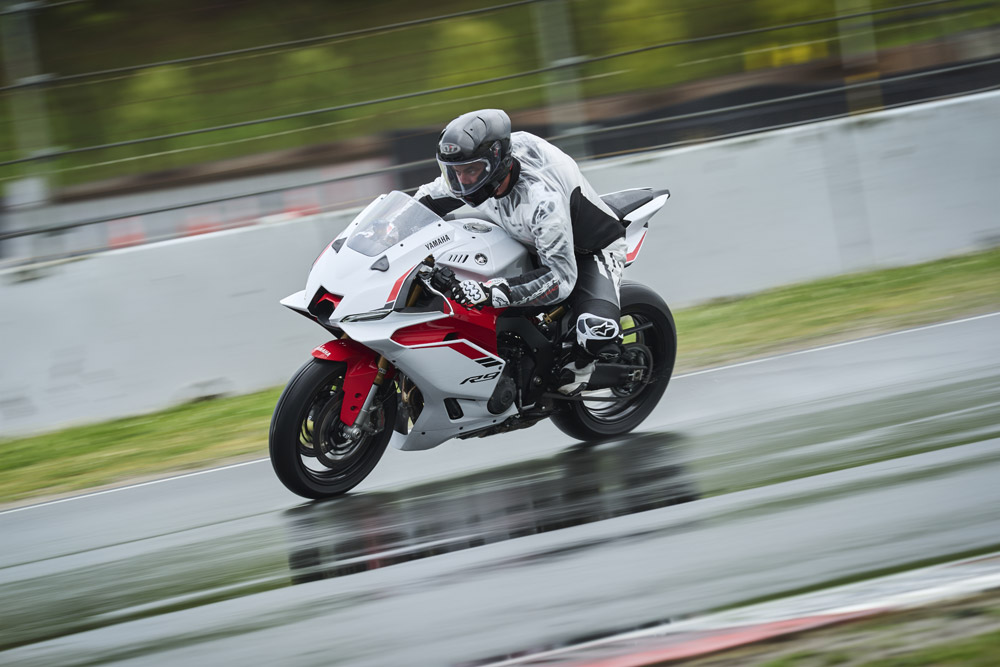
Aesthetically, the new R9 is an evolution of what we saw with the R1, with its winglets claimed to reduce front wheel lift by seven percent when you get hard on the gas in a straight line. Yamaha, conversely, claims the lift is reduced by 10 percent when you’ve got the bike leaned over in corners. I feel Yamaha’s done a decent job of trying to incorporate the catchy new winglets without making them too gaudy, but they do substantially increase the frontal area of the bike. A trim R6 with no wings still looks better in my book.
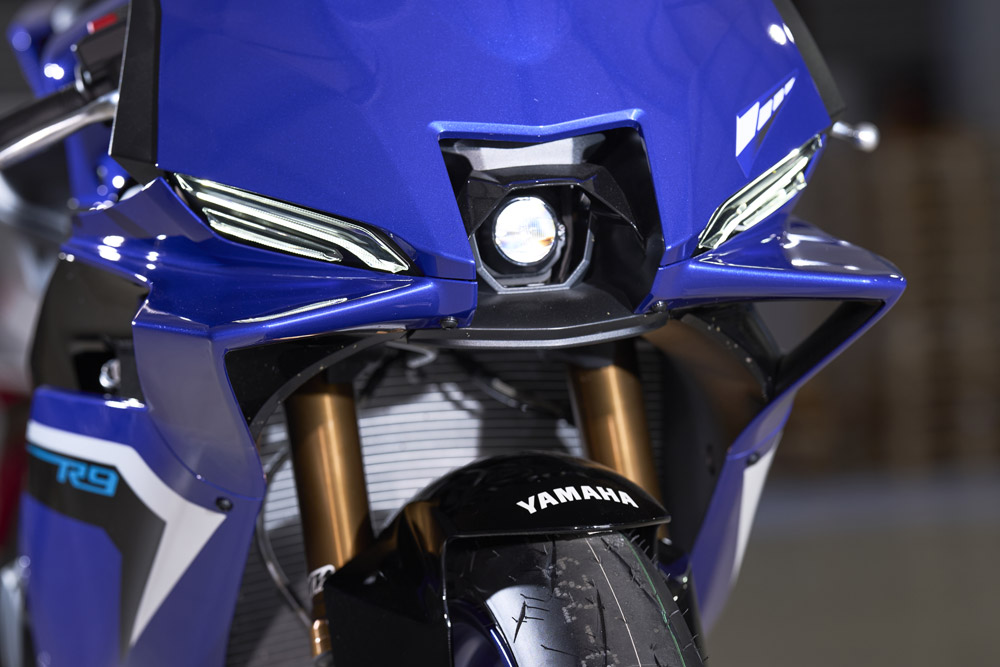
The R9 is by far the most important machine Yamaha has launched in the better part of a decade. The tuning-fork brand was once the king of the supersport class but, over time, has seen its dominance eroded by the European brands, and they seem to have hit the nail on the head with race results so far on the world level.
But for mere mortals, the R9 represents a massive shift in sportbike thinking. The more relaxed ergonomics make this a far easier machine to get the most out of compared to a razor-sharp R6, as does the torquey CP3 motor. It doesn’t have the traditional soundtrack of years gone by, but progress, especially in the supersport class that never saw any of it for what feels like decades, is a good thing. I don’t know about you, but I like to ride and not feel too beat up at the end of the day. I did the best part of 60 laps at Sonoma and felt perfectly fine at the end of it. I can’t say that about many other bikes I’ve ridden in the last five years.
The R6 may be gone, but it has a worthy successor in the R9, and that’s about the best compliment I can give Yamaha’s new supersport weapon. CN
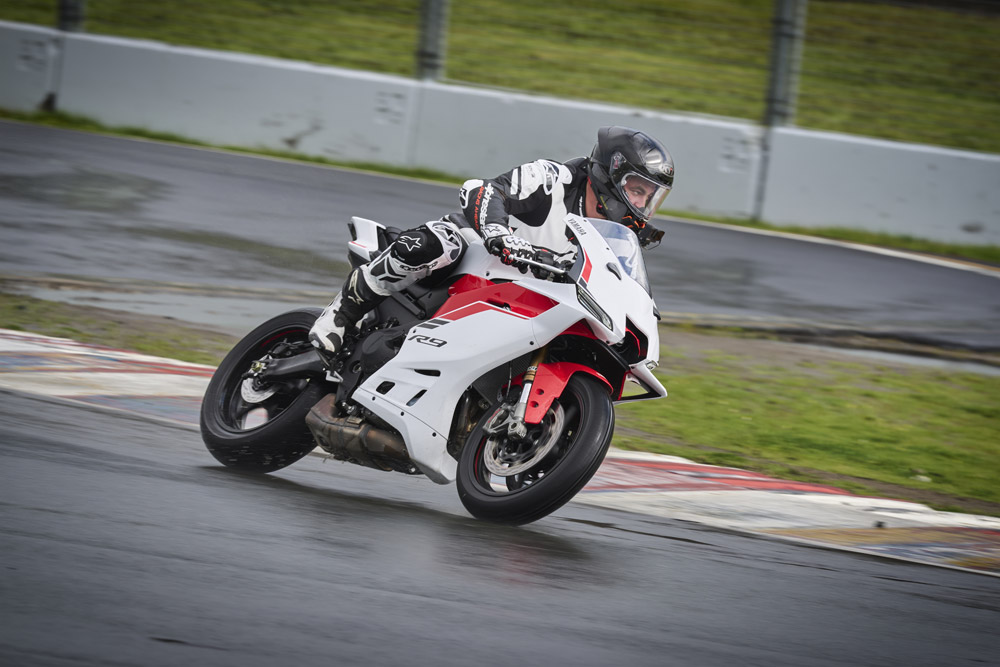
VIDEO | 2025 Yamaha YZF-R9 First Ride
2025 Yamaha YZF-R9 Specifications
| MSRP | $12,499 |
| Engine | Inline 3-cylinder |
| Valvetrain | 12-valve, DOHC, 240° firing order |
| Cooling system | Liquid |
| Displacement | 890cc |
| Bore x stroke | 78 x 62.1mm |
| Compression ratio | 11.5:1 |
| Max power (claimed) | 117 hp @ 10,000 rpm |
| Max Torque (claimed) | 68 lb-ft @ 7000 rpm |
| Fuel system | Electronic fuel-injection system YCC-T with ride-by-wire system |
| Exhaust | 3-2-1 |
| Transmission | Six-speed |
| Chassis | Cast aluminum twin-spar |
| Front suspension | 43mm KYB fork, fully adjustable |
| Rear suspension | KYB shock, fully adjustable |
| Front-wheel travel | 4.7 in. |
| Rear-wheel travel | 2.6 in. |
| Front brake | Dual 4-piston Brembo Stylema monobloc calipers, 320mm discs, ABS |
| Rear brake | Single-piston caliper, 220mm disc, ABS |
| Front tire | 120/70 ZR17 Bridgestone Battlax Hypersport S22 |
| Rear tire | 180/55 ZR17 Bridgestone Battlax Hypersport S22 |
| Rake | 27° |
| Trail | 3.7 in. |
| Wheelbase | 55.9 in |
| Seat height | 32.7 in. |
| Fuel capacity | 3.7 gal |
| Weight (wet, claimed) | 430 lbs. |
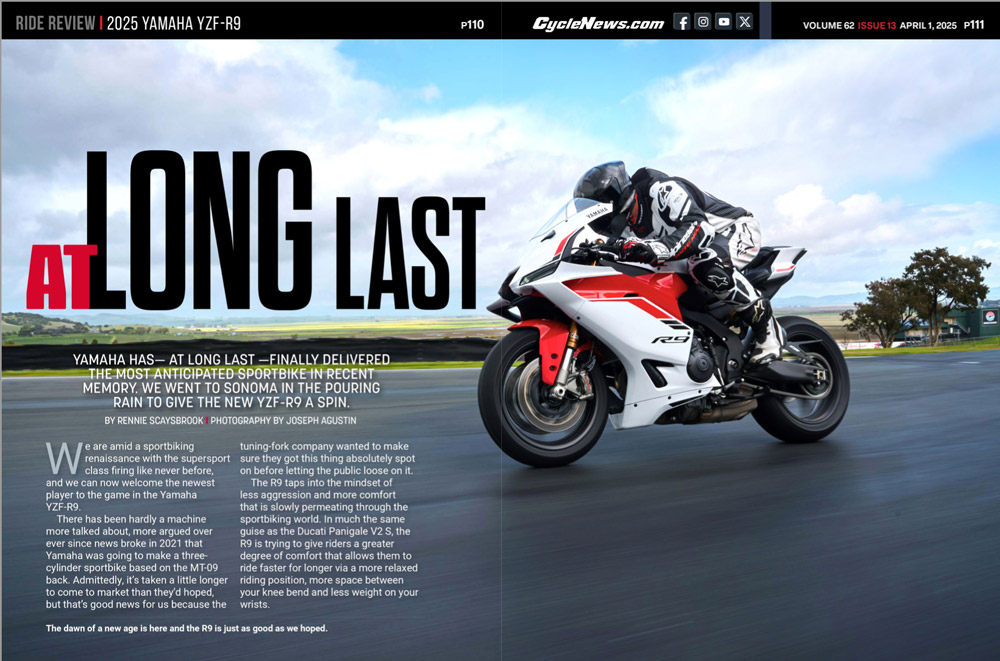
Click here to read the 2025 Yamaha YZF-R9 Review in the Cycle News Digital Edition Magazine.
Click here for the latest Cycle News Sportbike motorcycle reviews and news.
Click here for more Yamaha motorcycle reviews and news.
